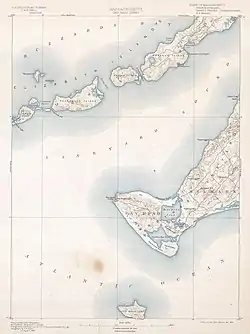Stonewall Pond
Stonewall Pond is a salt pond in the town of Chilmark, Massachusetts.[1] Stonewall Pond connects to Menemsha Pond via Nashaquitsa Pond.[2][3][4] The beach that separates Stonewall Pond from the Atlantic Ocean is called Stonewall Beach.[5]
| Stonewall Pond | |
|---|---|
 | |
| Location | Chilmark, Massachusetts |
| Type | Salt Pond |
| Basin countries | United States |
History
Archeological exploration indicates that indigenous peoples of the Wampanoag tribe have inhabited the shores of Stonewall Pond and the neighboring ponds for approximately 10,000 to 7,500 years.[6] In his 1969 book, Archaeology of Martha's Vineyard, William A Ritchie excavated and carbon-dated materials found in the shell middens and living sites around the Vineyard including Stonewall Pond.[7][8]
Storms
It is not uncommon during big storms for the Atlantic Ocean to breach Stonewall Beach and enter the Menemsha Pond ecosystem via Stonewall Pond.[1] In the historic 1938 New England hurricane, the Atlantic Ocean entered the ponds through Stonewall and decimated any buildings near the water, including almost the entire fishing village of Menemsha.[1]
References
- Burns, Cherie (June 2006). The Great Hurricane: 1938. Grove Press. ISBN 978-0-8021-4254-2.
- "Where Has All the Quitsa Eelgrass Gone? Crabs and Geese May Be to Blame". The Vineyard Gazette - Martha's Vineyard News. Retrieved 2020-05-02.
- "Chilmark Scallopers Husband Resources". The Vineyard Gazette - Martha's Vineyard News. Retrieved 2020-05-02.
- "Special Conservation District Declared for Menemsha and Nashaquitsa Ponds". The Vineyard Gazette - Martha's Vineyard News. Retrieved 2020-05-02.
- "Stonewall's Anomalies". Martha's Vineyard Magazine. 2009-09-01. Retrieved 2020-05-02.
- Hufstader, Louisa. "Aquinnah Sites Reveal 10,000 Years of Wampanoag History". The Vineyard Gazette.
- Ritchie, William A. (1969). Archaeology of Martha's Vineyard. NY.
- "Nashaquitsa Pond". Mapcarta. Retrieved 2020-05-02.